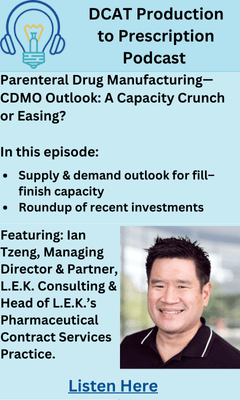CDMO/CMO Outlook: Fill-Finish: A Capacity Crunch or Capacity Easing?
What is the supply-demand outlook for fill–finish capacity in the CDMO/CMO sector? Is a capacity crunch or capacity easing in the making?
The injectables market: a manufacturing view
The supply–demand outlook for fill–finish capacity is in a period of flux. The market success of certain blockbuster products, such as the glucagon-1 peptide (GLP-1 agonists) used for treating Type 2 diabetes and obesity, has fueled demand for large-volume fill–finish capacity. This high demand has in part absorbed some of the strongly reduced demand in COVID-19 vaccines and products, which had been a principal driver for fill–finish capacity. At the same time, biologic-based drug development continues to fuel the market, but that has not been without some headwinds, particularly in the 2023-2024 time frame, due to a slowdown in biotech funding. Now in 2025, supply and demand for fill–finish capacity continues to re-calibrate. Overall demand for fill-finish capacity remains strong, but demand is varied based on evolving product needs, both on a volume and format basis. From a supply view, both bio/pharma companies and CDMOs/CMOs continue to invest in fill–finish capacity, with an estimated $1.5 billion to $2.0 billion of investment slated to come on line in the near term, just on the CDMO/CMO side.
“The injectables market is a highly dynamic market, where fluctuating demand and lagging supply can create perceptions of capacity restraints,” says Ian Tzeng, Managing Director and Partner, L.E.K. Consulting and head of L.E.K.’s Pharmaceutical Contract Services Practice. L.E.K. Consulting is a global management consulting firm, covering multiple industries, including the life sciences and pharmaceutical industries, and it recently issued a market analysis, Aligning Aseptic Fill–Finish Operations with Global Pharmaceutical Demand. “The fill–finish market remains a strong opportunity because new demand typically outpaces capacity’s ability to grow or adapt. This dynamic is likely to persist for the next five to 10 years despite significant investment from a wide range of in-house and outsourced providers,” says Tzeng. “As the demand for biologics and injectables grows, so too does the need for multi-purpose facilities that can quickly adjust to evolving market needs, making flexibility a key differentiator for that investment,” he adds.
Overall, the market for injectables is in the high single-digit growth, but there are nuances in the related demand and supply for fill–finish capacity, L.E.K. Consulting’s Tzeng explains. “This market is extremely dynamic, leading to challenges with ensuring enough capacity as well as putting existing capacity to optimal use,” he says. “There are many factors influencing capacity usage. Fluctuating and dynamic demand can create short-term supply imbalances while long lead times for new machines often keep supply lagging aggregate demand. In addition, on one level, there is the perception that capacity is tight, but the real challenge is finding the right capacity at the right throughput in the right geography and in the desired format, such as prefilled syringes, cartridges, or vials. Often, the challenge boils down to precise matchmaking to pair customers that are currently seeking capacity at certain scales and formats with available suppliers that can meet their manufacturing needs.”
Supply needs are further evolving with product demand. High-volume products, such as previously COVID vaccines and products or currently the GLP-1 agonists, or other high-volume injectables drive demand for large-scale fill–finish capacity. However, other new product development is also focused on products requiring smaller volumes, such as in precision medicines that address smaller patient populations. The result in less total volume demand for particular products although overall industry capacity needs are increasing.
The supply side: manufacturing investments
With overall demand robust, investment in fill–finish capacity is ongoing in the CDMO/CMO sector, including in consideration of capacity that will be leaving the market. Top of mind for the fill–finish market on the CDMO/CMO side is Novo Holdings’ $16.5-billion acquisition of the CDMO, Catalent, a deal which closed last December (December 2024) and Novo Holding’s subsequent sale of three fill–finish sites to Novo Nordisk for $11 billion to support Novo Nordisk’s blockbuster GLP-1 agonists, Ozempic/Wegovy (semaglutide), respectively for treating Type 2 diabetes and obesity. The deal netted Novo three fill–finish sites and related assets in Anagni, Italy, Bloomington, Indiana, and Brussels, Belgium. The Catalent acquisition is expected to gradually increase Novo Nordisk’s filling capacity from 2026 and onwards.
“We see in the Novo–Catalent deal how fill–finish capacity has become a strategic asset for bio/pharmaceutical companies, which are investing in-house capacity,” says Tzeng. This is underscored by not only the size of the Catalent–Novo deal, but is further reinforced with other billion-dollar-plus fill–finish capacity investments announced by Novo Nordisk and Eli Lily and Company to support product growth for their GLP-1 agonists drugs.
On the CDMO/CMO side, companies are also responding to demand and are increasing fill–finish capacity with an estimated 12 to 15 major investments totaling $1.5-billion to $2 billion (based on disclosed investments), coming on line in the 2024–2026 time frame, according to a recent analysis by L.E.K Consulting. Figure 1 outlines some of these key investments.
| Figure 1: Select Key Near-Term Investments by CDMOs/CMOs in Aseptic Fill–Finish Capacity | ||
|---|---|---|
| Company | Investment | Year On line |
| Jubilant HollisterStier | ≈ $285 M | 2024–2025 |
| Simtra BioPharma Solution | ≈ $250 M | 2025 |
| Vetter | ≈ $240 M | 2024 |
| Resilience | ≈ $225 M | 2025 |
| Grand River Aseptic Manufacturing | ≈ $160 M | 2026 |
| Kindeva Drug Delivery | ≈ $150 M | 2024 |
| PCI Pharma Services | ≈$100 M | 2025 |
| Selkirk | ≈$90 M | 2026 |
| Incog BioPharma Services | ≈ $75 M | 2025 |
| August BioServices | ≈ $65 M | 2024–2025 |
| Note: based on select disclosed investment amounts and limited to capacity additions slated to be on line in 2024–2026 time frame. M is millions. Source: Company information, industry publications, and L.E.K. Consulting research and analysis. |
||
In terms of aligning capacity with manufacturing needs and matching suppliers with bio/pharma customers, Tzeng points out that there are several factors that need to be considered in the calculus of capacity additions: throughput, format, and specialized handling requirements. The basic requirement is throughput, meaning a supplier must be able to meet the output volume required for a given project. Also, with respect to formats, dosing mechanisms, such as prefilled syringes and cartridges, require specialized equipment that may not be present in all aseptic fill–finish manufacturing setups, so CDMOs/CMOs are becoming adaptable. “To meet this shift, more suppliers are investing in flexible lines that can accommodate more needs,” he says. Additionally, specialized handling conditions, such as cold-chain requirements, are also necessary.







